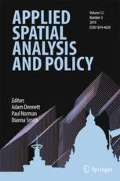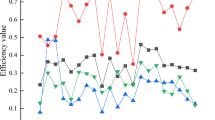Abstract
This study constructs tourism spatial gravity models with multi-destination and multi-origin interaction conditions, using consumer utility and travel probability theories. It also explores, through spatial correlation methods, the spatial differentiation characteristics of the tourism system in an urban agglomeration under the influence of a high-speed railway network from the perspectives of city tourism competitiveness and resident travel potential. The research finds that the high-speed railway has an increasing influence on the urban agglomeration tourism system, widening the hierarchical difference and causing the reverse balance to have an integration effect. The influence of high-speed railways has the obvious cluster node and corridor lock-in effect, which has strengthened the core-peripheral structure of the urban agglomeration tourism system. Peripheral cities with high-speed railways are more obviously affected, but their ranking-order changes in the urban agglomeration tourism system are not significant because of comprehensive location weaknesses. Because of the complex spatial differentiation, researchers need to use multi-spatial statistical methods to carry out integrated studies and obtain useful optimization strategies.








Similar content being viewed by others
References
Anselin, L. (1995). Local indicators of spatial association - LISA. Geographical Analysis, 27(2), 93–115.
Bergstrand, J.H. (1989). The generalized gravity equation, monopolistic competition, and the factor-proportions theory in international trade. The Review of Economics and Statistics, 71, 143–153.
Cascetta, E., Papola, A., Pagliara, F., & Marzano, V. (2011). Analysis of mobility impacts of the high speed Rome–Naples rail link using withinday dynamic mode service choice models. Journal of Transport Geography, 19(4), 635–643.
Cheng, Y. H. (2010). High-speed rail in Taiwan: New experience and issues for future development. Transport Policy, 17(2), 51–63.
Crampon, L. J. (1966). Gravitational model approach to travel market analysis. Journal of Marketing, 30(2), 27–31.
de Urena, J.M., Garmendia, M., Coronado, J.M., Vickerman, R.W., & Romero, V. (2010). New metropolitan processes encouraged by high-speed rail: The cases of London and Madrid, 12th WCTR, July 11–15, 2010, Lisbon, Portugal.
Edwards, S.L., & Dennis, S.J. (1976). Long distance day tripping in Great Britain. Journal of Transport Economics and Policy, 10, 237–256.
Eilat, Y., & Einav, L. (2004). Determinants of international tourism: A three-dimensional panel data analysis. Applied Economics, 36(12), 1315–1327.
Falk, M. (2016). A gravity model of foreign direct investment in the hospitality industry. Tourism Management, 55, 225–237.
Feng, C. C., Feng, X. B., & Liu, S. J. (2013). Effects of high speed railway network on the inter-provincial accessibilities in China. Progress in Geography, 32(8), 1187–1194.
Fröidh, O. (2005). Market effects of regional high-speed trains on the Svealand line. Journal of Transport Geography, 13(4), 352–361.
Gatrell, A. C. (1979). Autocorrelation in spaces. Environment and Planning A, 11(5), 507–516.
Givoni, M. (2006). Development and impact of the modern high-speed train: A review. Transport Reviews, 26(5), 593–611.
Gronau, W., & Kagermeier, A. (2007). Key factors for successful leisure and tourism public transport provision. Journal of Transport Geography, 15(2), 127–135.
Gunn, C.A. (1972). Vacationscape: Designing tourist regions. Austin: Bureau of Business Research, University of Texas.
Gunn, C. A., & Var, T. (2002). Tourism planning :Basics concepts cases(4 th ed). New York: Routledge.
Gutiérrez, J. (2001). Location, economic potential and daily accessibility: An analysis of the accessibility impact of the high-speed line Madrid–Barcelona–French border. Journal of Transport Geography, 9(4), 229–242.
Gutiérrez, J., Gonzalez, R., & Gomez, G. (1996). The European high-speed train network: Predicted effects on accessibility patterns. Journal of Transport Geography, 4(4), 227–238.
Hall, C. M. (2005). Tourism: Rethinking the social science of mobility. Pearson Education.
Hall, C. M. (2012). Spatial analysis: a critical tool for tourism geographies. In J. Wilson (Ed.), The Routledge handbook of tourism geographies (pp. 163–173). New York: Routledge.
Hall, C. M., Le-Klähn, D.-T., & Ram, Y. (2017). Tourism, public transport and sustainable mobility. Bristol: Channel View Press.
Hall, P. (2009). Magic carpets and seamless webs: Opportunities and constraints for high-speed trains in Europe. Built Environment, 35(1), 59–69.
Harman, R. (2006). High speed trains and the development and regeneration of cities. London: Green gauge, 21(6), 5–126.
He, D., & Yang, B. (2013). Impact of high-speed railways on accessibility. Resources and Environment in the Yangtze Basin, 22(10), 1264–1275.
Hou, X., Liu, S., & Zhang, W. X. (2011). Characteristics of commuting behaviors between Beijing and Tianjing influenced by high speed train. Economic Geography, 31(9), 1573–1579.
Huang, T. (2016). Evolution characteristics and factors affecting tourist flow potential in the Yangtze River Delta urban agglomerations. Resources Science, 38(2), 364–376.
Huang, T., Zha, A. H., Ying, N. X., & Wei, X. D. (2014). The evolution of urban tourism service ability pattern under the influence of high-speed rails: The case of the Yangtze River Delta. Economic Geography, 34(11), 158–165.
Jafari, J. (1992). Towards tourism mitigation: recognizing cultural forms and forces influencing freedom for traveling. In The Freedom of Traveling in the Year (Vol. 34, pp. 89–104). AIEST: St. Gallen.
Jiang, H. B., Xu, J. G., & Qi, Y. (2010). The influence of Beijing-shanghai high-speed railways on land accessibility of regional center cities. Acta Geographing Sinica, 65(10), 1287–1298.
Jiang, H. B., Liu, J. G., & Jiang, J. L. (2014). An analysis of the accessibility of China’s tourist attractions under the impact of high-speed railway. Tourism Tribune, 29(7), 58–67.
Kaul, R. N. (1985). Dynamics of tourism:A trilogy transportation and marketing. New Delhi: Sterling Publishers.
Keum, K. (2010). Tourism flows and trade theory: A panel data analysis with the gravity model. The Annals of Regional Science, 44(3), 541–557.
Khadaroo, J., & Seetanah, B. (2007). Transport infrastructure and tourism development. Annals of Tourism Research, 34(4), 1021–1032.
Khadaroo, J., & Seetanah, B. (2008). The role of transport infrastructure in international tourism development: A gravity model approach. Tourism Management, 29(5), 831–840.
Lee, J., & Wong. D.W.S., (2001). Statistical Analysis with ArcView GIS. John Wiley & Sons, 156–164.
Leiper, N. (1979). The framework of tourism. Annals of Tourism Research, 6(4), 390–407.
Leiper, N. (1995). Tourism Management. Collingwood: TAFE Publications.
Levinson, D. M. (2012). Accessibility impacts of high-speed rail. Journal of Transport Geography, 22, 288–291.
Liu, F. Y. (2010). Research of tourism consumer demand change in the era of fast trip times: Case Guangdong, Hubei and Hunan under the Wuhan-Guangzhou high-speed railway operation. Academic Forum, 2, 77–79.
Lorde, T., Li, G., & Airey, D. (2016). Modeling Caribbean tourism demand: An augmented gravity approach. Journal of Travel Research, 55(7), 946–956.
Lu, L. (2013). Research progress on tourism development in metropolitan areas. Acta Geographica Sinica, 68(4), 532–546.
Martínez Sánchez-Mateos, H. S., & Givoni, M. (2012). The accessibility impact of a new high-speed rail line in the UK - a preliminary analysis of winners and losers. Journal of Transport Geography, 25, 105–114.
MartíSelva, L., & Puertas, M. (2017). Characterisation of Spanish tourism by type of accommodation: a gravity model approach. Investigaciones Turísticas, 13, 77–95.
Masson, S., & Petiot, R. (2009). Can the high speed rail reinforce tourism attractiveness? The case of the high speed rail between Perpignan (France) and Barcelona (Spain). Technovation, 29, 611–617.
McKercher, B., & Lew, A. (2003). Distance decay and the impact of effective tourism exclusion zones on in international travel flows. Journal of Travel Research, 42(2), 159–165.
Morley, C., Rosselló, J., & Santana-Gallego, M. (2014). Gravity models for tourism demand: Theory and use. Annals of Tourism Research, 48, 1–10.
Murayama, Y. (1994). The impact of railways on accessibility in the Japanese urban system. Journal of Transport Geography, 2(2), 87–100.
Orsi, F. (Ed.). (2015). Sustainable transportation in natural and protected areas. Abingdon: Earthscan by Routledge.
Ortega, E., López, E., & Monzón, A. (2012). Territorial cohesion impacts of high-speed rail at different planning levels. Journal of Transport Geography, 24, 130–141.
Outwater, M., Tierney, K., Bradley, M., et al. (2010). California statewide model for high-speed rail. Journal of Choice Modelling, 3(1), 58–83.
Park, J. Y., & Jang, S. (2014). An extended gravity model: Applying destination competitiveness. Journal of Travel & Tourism Marketing, 31(7), 799–816.
Peeters, P., Szimba, E., & Duijnisveld, M. (2007). Major environmental impacts of European tourist transport. Journal of Transport Geography, 15(2), 83–93.
Prideaux, B. (2000). The role of the transport system in destination development. Tourism Management, 21(1), 53–63.
Reilly, J., Williams, P., & Haider, W. (2010). Moving towards more eco-efficient tourist transportation to a resort destination: The case of whistler, British Columbia. Research in Transportation Economics, 26(1), 66–73.
Santana-Gallego, M., Ledesma-Rodríguez, F. J., & Pérez-Rodríguez, J. V. (2016). International trade and tourism flows: An extension of the gravity model. Economic Modelling, 52, 1026–1033.
Santeramo, F. G., & Morelli, M. (2016). Modelling tourism flows through gravity models: A quantile regression approach. Current Issues in Tourism, 19(11), 1077–1083.
Sasaki, K., Ohashi, T., & Ando, A. (1997). High-speed rail transit impact on regional systems: Does the Shinkansen contribute to dispersion? The Annals of Regional Science, 31(1), 77–98.
Smith, S. L. (1989). Tourism analysis: A handbook. Harlow: Longman.
Stillwell, J., & Birkin, M. (2008). Editorial: The case for ASAP. Applied Spatial Analysis and Policy, 1, 1–4.
Vickerman, R. (1997). High-speed rail in Europe: Experience and issues for future development. The Annals of Regional Science, 31(1), 21–38.
Wang, D., & Liu, K. (2003). Dynamic changes and spatial characteristics of Shanghai’s daily-communication-area. Urban Planning Forum, 3, 3–10.
Wang, D. G. (2014). The influence of Beijing-shanghai high-speed railway on tourist flow and time-space distribution. Tourism Tribune, 29(1), 75–82.
Wang, J. E., & Ding, J. X. (2011). High-speed rail and its impacts on the urban spatial structure of China. Urban Planning International, 26(6), 49–54.
Wang, J. E., & Hu, H. (2012). Accessibility of medium- and small-sized cultural tourist cities based on spatial distance and time cost. Journal of Natural Resources, 27(11), 1951–1961.
Wang, X., Huang, S., Zou, T., & Yan, H. (2012). Effects of the high speed rail network on China's regional tourism development. Tourism Management Perspectives, 1, 34–38.
Wei, X. A., & Jin, Z. (2012). Tourism development in the high-speed era in China. Tourism Tribune, 27(12), 40–46.
Wilson, J. (Ed.). (2012). The Routledge handbook of tourism geographies. Routledge.
Wolfe, R. I. (1972). The inertia model. Journal of Leisure Research, 4, 73–76.
Wu, K., Fang, C. L., Zhao, M. X., et al. (2013). The intercity space of flow influenced by high-speed rail: A case study for the rail transit passenger behavior between Beijing and Tianjin. Acta Geographica Sinica, 68(2), 159–174.
Yin, M., Bertolini, L., & Duan, J. (2015). The effects of the high-speed railway on urban development: International experience and potential implications for China. Progress in Planning, 98, 1–52.
Zhang, W. X., Liu, X. X., Yang, C. Z., et al. (2013). Study on the impact of high speed railway on urban tourism: Taking Nanjing as an example. Economic Geography, 33(7), 163–168.
Zhang, Y., Li, X., & Wu, T. (2017). The impacts of cultural values on bilateral international tourist flows: a panel data gravity model. Current Issues in Tourism, 20, 1–15.
Zhong, S. E., Zhang, J., Han, G. S., et al. (2010). Spatial patterns of tourist flow: Problems and prospects. Human Geography, 25(2), 31–36.
Acknowledgements
This work is supported by the National Social Science Foundation of China (Grant no. 17BGL123), the National Natural Science Foundation of China (Grant no. 41671151) and the Key projects of China National Tourism Administration Research Foundation (Grant no. 16TAAK004).
Author information
Authors and Affiliations
Corresponding author
Rights and permissions
About this article
Cite this article
Huang, T., Xi, JC. & Ge, QS. Spatial Differentiation and Integration Optimization of an Urban Agglomeration Tourism System under the Influence of High-Speed Railway Network Evolution. Appl. Spatial Analysis 12, 349–376 (2019). https://doi.org/10.1007/s12061-017-9245-3
Received:
Accepted:
Published:
Issue Date:
DOI: https://doi.org/10.1007/s12061-017-9245-3




